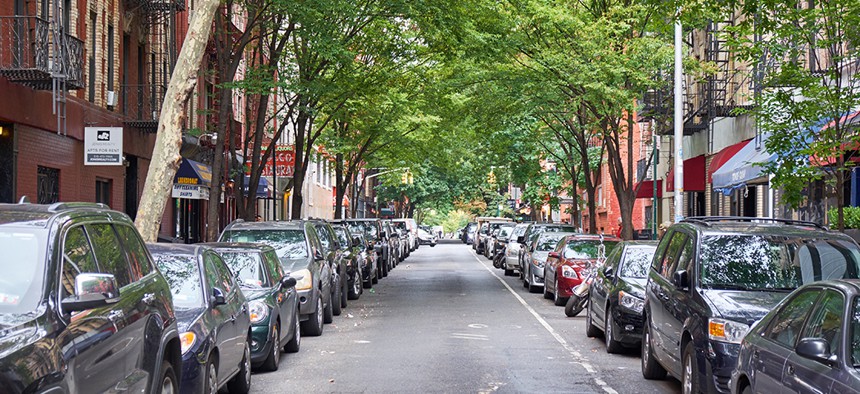For one of the world’s most densely populated islands at the heart of a transit-rich city, Manhattan has a lot of free parking. This public subsidy for car owners exists in even the most expensive parts of the borough, where private garages charge as much for a parking space as it costs to buy a house in many cities.
Unsurprisingly, demand is high for free parking in Manhattan. Residents have long complained of visiting drivers using their neighborhood streets as a parking lot. Bridge-and-tunnel folks don’t only park near their destination; some will park as soon as they enter Manhattan and then take the subway.
New York is contemplating policies to address the problem of too many people driving on the crowded streets of Manhattan, including congestion fees. (A small first step was taken in the new state budget, which added surcharges to taxis and ride-hailing services like Uber and Lyft.) A pair of recently introduced bills in the New York City Council would reserve the majority of street parking in Upper Manhattan for residents, though state and city transportation officials said that it would require enabling legislation in Albany to be implemented.
But one of the simplest ways to stop people from driving into Manhattan would be for the city to stop using valuable real estate as free parking.
In his seminal book, “The High Cost of Free Parking,” UCLA urban planning professor Donald Shoup cited 16 studies showing that, on average, 30 percent of cars in congested traffic on city streets were cruising for parking. One 1995 study found that in Manhattan, drivers averaged more than 10 minutes searching for parking between 11 p.m. and 2 a.m. Shoup advocates charging a price that will reduce demand just enough to ensure that spaces are fully used, but without a surplus of drivers searching for free parking.
In the New York City context, however, this could result in wealthier suburbanites snatching all the available parking spaces and leaving residents in lower-income communities frozen out.
Most American homeowners park in their own driveway, but some cities have neighborhoods, like those in Manhattan, where residents rely on street parking. Such cities – Washington, D.C., for example – mostly regulate street parking on residential streets with a residential parking permit program.
Reserving parking for local residents would discourage others from driving into the most congested parts of the city and prevent city neighborhoods from being used as a parking lot for suburbanites. It would also ensure that the people living there have access to parking, rather than whoever can afford to pay.
So residential parking permits could have benefits but also unintended consequences. If the city simply converted on-street spaces to resident permit parking, it would be easier for residents to drive on a regular basis since it would no longer be so difficult to find a space. That means it would be much easier to own a car as a city resident.
"Make something easier and you likely will get more of it. But does the city want more Manhattanites to own cars and drive around the city?"
Make something easier and you likely will get more of it. But does the city want more Manhattanites to own cars and drive around the city? That would reduce the benefits of reducing congestion and pollution by discouraging suburbanites from driving into the city.
At the very least, the city should charge for the resident parking permits, at a price commensurate with the value of the land in the neighborhood. Shoup has demonstrated the perverse incentives created when governments effectively subsidize parking, such as increased traffic. It hardly makes sense to charge residents a fare every time they use transit, while providing a large plot of public land for them to park their cars for free. With rates geared to local land costs, parking will remain affordable for those who need it in lower-income communities. Exemptions could be provided for people who need a car for work, or due to a disability. Charging allows the city to capture the added property value created for properties that will have access to parking spaces in Manhattan, rather than further exacerbating the city’s housing affordability crisis.
Maintaining the same number of spaces, however, will not fully address the issue of too many people driving. There are many other potential uses for the valuable real estate now occupied by street parking. Many of these uses would offer far more to the neighborhood than parking for a few cars. Among the many options include gardens and green space, benches and other rest areas, bicycle parking, bike lanes and dedicated transit lanes. (It is within the city’s own powers to reallocate road space, unlike many other congestion-related policies that require state approval.)
Little forethought went into the allocation of so many on-street parking spaces across the city. Officials generally allocated whatever street space was not required for through traffic to parking.
Parking is far from the best use of Manhattan’s valuable land. Over a quarter of Manhattan’s space is dedicated to roads, a good proportion of which are in turn dedicated to street parking. This is surely not the highest and best use of this prized real estate.


